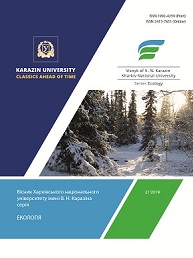Revitalization Processes of Changing Geospatial in European Cities
Abstract
Purpose. Brief retrospective analysis of the geographical component of revitalization in European cities, study of the generalized and indirect effect of the revitalization phenomenon on the geospace of urban urban systems.
Results. The results of the study of revitalization processes in European cities are presented. European cities are characterized by uneven development, concentration of potential in the capital and some regional centers, as well as the increase of crisis phenomena in the periphery. We are talking about depressed territories, settlements, post-industrial cities or parts of them. That is why we consider it necessary to speak not only about the restoration of potential and improvement of socio-economic indicators in cities, but also about the large-scale implementation of urban space revitalization programs. Approaches to revitalization processes are ideally designed as processes for empowering unused urban space. At the same time, they should be aimed at ensuring the effective use of public and private financed bonds and project funds for projects from the Civic Control Center. The main requirement of the community is to begin the process of updating and involving the administration in these projects. The first round of negotiations between the authorities and society prompted the city to come up with a coherent approach aimed at the target group and at the same time agree on the financial budget and future beneficiaries. In addition to those responsible for urban planning, special roles are assigned to local departments of schools, youth, senior citizens and business development (business, marketing and investor talks). It is these areas of human and financial capital that should be responsible for urban marketing and tourism. The involvement of a restructuring trustee in project planning and development is required.
Conclusion. Taking into account the geographical component (in particular the topography, vegetation, green areas), as a result of the revitalization helps to improve the quality of living environment and affects the peculiarities of the geospatial of the city. An important component of the success of a revitalization program must be public participation in discussing and solving problems to ensure sustainable urban development. Studying the experience of European cities in the area of revitalization will give a new impetus to many Ukrainian cities trying to overcome the problems of deprived urban areas, including the historic central districts and mediocrity.
Downloads
References
Bronevitsky, A. P. (2017). Features of revitalization of industrial buildings. ACADEMIC JOURNAL Series: Industrial Machine Building, Civil Engineering, 2(44), 65-69. Retrieved from http://journals.nupp.edu.ua/znp/article/view/147 (In Ukranian).
Savyovsky, V. Bronevitskiy A., Karzhinerova A. (2014). Revitalization-ecological reconstruction of urban development. Bulletin of the PDAB, (8), .47-52. (In Ukranian).
Zapototsky, S. F., Levitskaya, A. F. (2016). Revitalization of industrial objects of the city (on the example of Ivano-Frankivsk city). Journal of Socio-Economic Geography, 21 (2), 102-106. (In Ukranian).
Popova, O. A. (2013). Basic requirements for loft housing and the advantages of industrial buildings in the conditions of their reorganization. Bulletin of BSTU named after V.G. Shukhov., (4), 22-26. file:///C:/Users/bazkakovaLV/Downloads/4_2013.pdf (In Russian).
Nazaruk, M. M. (2016). Revitalization as a step towards ecologically balanced development of the city of Lviv. Bulletin of Lviv University. The series is geographical, (50), 271–276. (In Ukranian).
Lviv-Pidzamche Revitalization Program. 2012–2025. (2011). Kraków – Lwów.. (In Ukranian).
Rybchinskiy, O. V. (2011). The program and design components of the revitalization of market areas of historic cities of Ukraine. Urban planning and territorial planning, 381-388. (In Ukranian).
Sych, O. A. (2016). Revitalization as a Mechanism for Sustainable Urban Development.European Perspec-tives, (1), 27-30. (In Ukranian).
Błaszczyk M., Kłopot S. W., Kozdraś G. (2010). Problemy społeczne w przestrzeni miasta. Raport z badań socjologicznych nad mieszkańcami miasta. Wrocławska Diagnoza Problemów Społecznych, Miejski Ośrodek Pomocy Społecznejwe Wrocławiu, Wrocław.
Wiener-Gasometer . Retrieved from http://www.wiener-gasometer.at
Gasometer (2016). Retrieved from http://www.gasometer-city.eu/umbau.htm
Stadtsanierung BayreuthVorbereitende Untersuchungen InnenstadtAufnahme in das Bund-Länder-Städtebauförderungs- programm „Aktive Stadt- und Ortsteilszentren. (2010). Retrieved from : https://www.bayreuth.de/wp-content/uploads/2015/06/2010-09-VU-Innenstadt-Bth-Kurzfassg_mBildern.pdf
Authors who publish with this journal agree to the following terms:
- Authors retain copyright and grant the journal right of first publication of this work under the terms of a license Creative Commons Attribution License 4.0 International (CC BY 4.0).
- Authors are able to enter into separate, additional contractual arrangements for the non-exclusive distribution of the journal's published version of the work (e.g., post it to an institutional repository or publish it in a book), with an acknowledgement of its initial publication in this journal.
- Authors are permitted and encouraged to post their work online (e.g., in institutional repositories or on their website) prior to and during the submission process, as it can lead to productive exchanges, as well as earlier and greater citation of published work.





